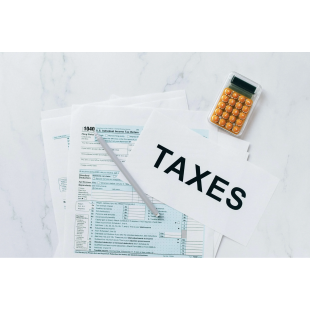All News
-

Year-round tax planning pointers for taxpayers
Here are some simple things taxpayers can do throughout the year to make filing season less stressful.
Organize tax records. Create a system that keeps all important information together. Taxpayers can use a software program for electronic recordkeeping or store paper documents in clearly labeled folders. They should add tax records to their files as they receive them. Organized records will make tax return preparation easier and may help taxpayers discover overlooked deductions or credits.
Identify filing status. A taxpayer's filing status determines their filing requirements, standard deduction, eligibility for certain credits and the correct amount of tax they should pay. If more than one filing status applies to a taxpayer, they can get help choosing the best one for their tax situation with the IRS’s Interactive Tax Assistant, What Is My Filing Status. Changes in family life — marriage, divorce, birth and death — may affect a person's tax situation, including their filing status and eligibility for certain tax credits and deductions.
Understand adjusted gross income (AGI). AGI and tax rate are important factors in figuring taxes. AGI is the taxpayer's income from all sources minus any adjustments. Generally, the higher a taxpayer's AGI, the higher their tax rate and the more tax they pay. Tax planning can include making changes during the year that lower a taxpayer's AGI.
Check withholding. Since federal taxes operate on a pay-as-you-go basis, taxpayers need to pay most of their tax as they earn income. Taxpayers should check that they're withholding enough from their pay to cover their taxes owed, especially if their personal or financial situations change during the year. To check withholding, taxpayers can use the IRS Withholding Estimator. If they want to change their tax withholding, taxpayers should provide their employer with an updated Form W-4.
Make address and name changes. Taxpayers should notify the United States Postal Service, employers and the IRS of any address change. To officially change a mailing address with the IRS, taxpayers must compete Form 8822, Change of Address, and mail it to the correct address for their area. For detailed instructions, see page 2 of the form. Report any name change to the Social Security Administration. Making these changes as soon as possible will help make filing their tax return easier.
Save for retirement. Saving for retirement can also lower a taxpayer's AGI. Certain contributions to a retirement plan at work and to a traditional IRA may also reduce taxable income.
Source: IRS.gov
US TAX, U.S. TAX
Year-round tax planning pointers for taxpayersmore -

Reminder: Taxpayers must file and pay taxes even if they live abroad
It’s important that U.S. citizens and resident aliens living abroad understand their tax obligations.
Their worldwide income -- including wages, unearned income and tips -- is subject to U.S. income tax, regardless of where they live or where they earn their income. They also have the same income tax filing requirements as U.S. citizens or resident aliens living in the United States.
An income tax filing requirement applies even if a taxpayer qualifies for tax benefits such as the Foreign Earned Income Exclusion or the Foreign Tax Credit, which reduce or eliminate U.S. tax liability. These tax benefits are available only if the eligible taxpayer files a U.S. income tax return.
Taxpayers living outside of the U.S. and Puerto Rico have an automatic extension to file – but not to pay
A taxpayer has an automatic two-month extension to June 17, 2024, if both their tax home and abode are outside the United States and Puerto Rico. Even with an extension, a taxpayer will have to pay interest on any tax that wasn’t paid by the regular April due date.
Those serving in the military outside the U.S. and Puerto Rico on the regular due date of their tax return also qualify for the extension to June 17, 2024. Taxpayers should attach a statement to their tax return if one of these two situations applies. More information is in the instructions for Form 1040 and Form 1040-SR, Publication 54, Tax Guide for U.S. Citizens and Resident Aliens Abroad, and Publication 519, U.S. Tax Guide for Aliens.
Reporting requirement for foreign accounts and assets
Federal law requires U.S. citizens and resident aliens to report their worldwide income, including income from foreign trusts and foreign bank and other financial accounts.
Schedule B (Form 1040), Interest and Ordinary Dividends – In most cases, affected taxpayers attach Schedule B to their federal return to report foreign assets. Part III of Schedule B asks about the existence of foreign accounts such as bank and securities accounts and usually requires U.S. citizens and resident aliens to report the country in which each account is located.
Form 8938, Statement of Foreign Financial Assets – Some taxpayers may also need to attach Form 8938 to their return to report specified foreign financial assets if the total value of those assets exceeds certain thresholds. The instructions for this form have the details.
People must also report foreign assets of $10,000 or more to the Treasury Department
U.S. persons with an interest in or signature or other authority over foreign financial accounts where the total value exceeded $10,000 at any time during 2023 must also file a Financial Crimes Enforcement Network (FinCEN) Form 114, Report of Foreign Bank and Financial Accounts with the Treasury Department. The form is available only through the BSA E-filing System website.
The deadline for filing the annual Report of Foreign Bank and Financial Accounts was April 15, 2024. U.S. persons who missed the April deadline have an automatic extension until Oct. 15, 2024, to file the FBAR.
Source: IRS.gov
US TAX, U.S. TAX
Reminder: Taxpayers must file and pay taxes even if they live abroadmore -

How to request help with a tax matter from the IRS Independent Office of Appeals
If a taxpayer disagrees with an IRS decision, they can ask the IRS Independent Office of Appeals to review their case. This office is separate from the rest of the IRS. Appeals officers review cases that taxpayers submitted, meet with the taxpayer informally and consider the taxpayer’s position and the IRS's position in a fair and unbiased manner.
Overview of the appeals process
Here's what taxpayers need to know if they want to appeal their case:
To submit an appeal request, taxpayers mail their request in writing to the office that sent them the letter with their appeal rights. For information on filing a formal written protest or a small case request, taxpayers should review Publication 5, Your Appeal Rights and How To Prepare a Protest If You Disagree. The IRS office that receives the request will consider the taxpayer's request and attempt to resolve the disputed tax issues. If that office can't resolve the taxpayer's issues, they will forward the case to Appeals for consideration.
Once the request is with Appeals, the Appeals officer contacts the taxpayer within 45 days by mail to schedule an informal conference to review the taxpayer's situation. Appeals conducts conferences by phone, in person and by video. Taxpayers may choose which type of conference they prefer.
At the conference, the Appeals officer discusses with the taxpayer the law as it applies to the facts of the case, including court rulings on similar cases.
If a taxpayer hasn't heard about their appeal andit's been more than 120 days since they filed their request, taxpayers can ask for a status update by contacting the IRS office they worked with last.
If the taxpayer sends new information or documents to Appeals, the Appeals officer may need to send the case back to the original IRS office to review the new information. Appeals will not raise new issues or reopen issues agreed to by the taxpayer or the IRS except in cases of potential fraud or malfeasance.
Appeals officers review the facts, the law, the taxpayer's comments and information the taxpayer and the IRS office presented before they make a final decision. They will also explain to the taxpayer the reasons for the decision and their options. Generally, there are three outcomes of an appeal:
In the IRS's favor: If the facts and laws support the government's position, the Appeals officer recommends that the taxpayer concede and give up the issue.
In the taxpayer's favor: If the law and facts support the taxpayer's position or courts have ruled in favor of taxpayers in similar cases, the Appeals officer recommends that the IRS concede and give up the issue.
Compromise: The Appeals officer may recommend a compromise when the facts or laws are unclear or the courts have made different rulings on similar cases. In this situation, Appeals may recommend a settlement where the taxpayer pays a percentage of the tax due.
Interest continues to add up on any unpaid balance a taxpayer owes as Appeals reviews a case.
Source: IRS.gov
US TAX, U.S. TAX
How to request help with a tax matter from the IRS Independent Office of Appealsmore -

If taxpayers missed the deadline to file a federal tax return, the IRS can help
If taxpayers missed the deadline to file a federal tax return, the IRS can help
Taxpayers who missed the April tax filing and payment deadline should file as soon as they can. The IRS offers resources to help those who may be unable to pay their tax bill in total. Those who missed the deadline to file but owe taxes should file quickly to minimize penalties and interest.
Taxpayers should keep in mind that payments are still due by the April 15 deadline, even if they requested an extension of time to file a tax return. An extension to file is not an extension to pay.
Depending on their circumstances, some taxpayers have more time to file and pay.
Taxpayers who owe tax
Taxpayers who still owe taxes should file their tax return and pay any taxes owed quickly to reduce penalties and interest. Until the balance is paid in full, interest and penalties accrue on taxes owed.
Even if a taxpayer can't afford to immediately pay the full amount of taxes owed, they should still file a tax return and pay as much as possible. This reduces interest and penalties on the outstanding amount and may help avoid a possible late-filing penalty.
There are options for taxpayers who owe the IRS but cannot afford to pay. For more information see the penalties page on IRS.gov.
Taxpayers may qualify for penalty relief if they have filed and paid timely for the past three years and meet other important requirements, including paying or arranging to pay any tax due. For more information, see the first-time penalty abatement page on IRS.gov.
Taxpayers who don’t owe tax or are owed a refund
Taxpayers who choose not to file a return because they don't earn enough to meet the filing requirement may miss out on receiving a refund due to potential refundable tax credits. Some examples are the Earned Income Tax Credit and Child Tax Credit. Taxpayers sometimes fail to file a tax return and claim a refund for these credits and others for which they may be eligible.
There's no penalty for filing after the April 15 deadline if a refund is due. However, taxpayers due a refund should still consider filing as soon as possible.
Members of the military community can still use MilTax
Eligible members of the military community can also file their taxes using MilTax, a free tax resource offered through the Department of Defense. Eligible taxpayers can use MilTax to electronically file a federal tax return and up to three state returns for free.
Some taxpayers have extra time
Some taxpayers automatically qualify for extra time to file and pay taxes due without penalties and interest, including:
Taxpayers in certain disaster areas. There’s no need for these taxpayers to submit an extension; extra time is granted automatically due to the disaster. Information on the most recent tax relief for disaster situations is available on the IRS website.
U.S. citizens and resident aliens who live and work outside of the United States and Puerto Rico.
Members of the military on duty outside the United States and Puerto Rico, and those serving in combat zones.
Source: IRS.gov
US TAX, U.S. TAX
If taxpayers missed the deadline to file a federal tax return, the IRS can helpmore -

Tax credits for individuals: What they are and how they can benefit taxpayers
Tax credits for individuals: What they are and how they can benefit taxpayers
A tax credit is an amount taxpayers claim on their tax return generally to reduce their income tax. Eligible taxpayers can use them to potentially reduce their tax bill and increase their refund.
Refundable vs. nonrefundable tax credits
Some tax credits are refundable. If a taxpayer's tax bill is less than the amount of a refundable credit, they can get the difference back in their refund. Some taxpayers who aren't required to file may still want to do so to claim refundable tax credits. Not all tax credits are refundable, however. For nonrefundable tax credits, once a taxpayer's liability is zero, the taxpayer won't get any leftover amount back as a refund. There are a wide range of tax credits, and the amount and types available can vary by tax year. Taxpayers should carefully review current tax credits when preparing their federal tax return.
Earned Income Tax Credit
One refundable tax credit for moderate- and low-income taxpayers is the Earned Income Tax Credit (EITC). The IRS estimates four out of five eligible workers claim the EITC, which means millions of taxpayers are putting EITC dollars to work for them. Unfortunately, there are millions of workers who qualify but don't claim the EITC - missing out on thousands of dollars every year. This includes workers who are: Grandparents raising their grandchildren. Native Americans. Veterans. Self-employed. Without a qualifying child. Recently divorced, unemployed or experienced other changes to their marital, financial or parental status. Below the filing requirement with earnings. Not proficient in English. Living in rural areas. Receiving certain disability pensions or have children with disabilities. Taxpayers can find detailed information in Publication 596, Earned Income Credit, or use the EITC Assistant to learn if they're eligible for the tax credit.
Child Tax Credit and Child and Dependent Care Tax Credit The Child Tax Credit is nonrefundable and reduces the taxpayer's tax liability. To qualify, the child must: Be a U.S. citizen, U.S. national, or U.S. resident under age 17. Have a Social Security number. Be claimed as a dependent on the taxpayer's tax return. Qualifying children may include foster children or extended family members if they meet other criteria. Dependents not eligible for the Child Tax Credit may qualify a taxpayer for the credit for other dependents. Taxpayers who paid someone to care for their child, spouse or dependent so they can work, be a full-time student or look for work may be able to reduce their tax by claiming the Child and Dependent Care Credit. Publication 503, Child and Dependent Care Expenses, has detailed information.
American Opportunity Tax Credit
The American Opportunity Tax Credit is for qualified education expenses paid by or on behalf of an eligible student for the first four years of higher education. It is partially refundable. If the credit reduces the amount of tax a taxpayer owes to zero, they can get a refund of 40% of any remaining amount of the credit, up to $1,000. Taxpayers can get a maximum annual credit of $2,500 per eligible student. The amount of the credit is 100% of the first $2,000 and 25% of the next $2,000 of qualified education expenses a taxpayer paid for each eligible student. To claim the full credit, a taxpayer's income must be $80,000 or less ($160,000 or less for married filing jointly). The credit phases out entirely for taxpayers with income over $90,000 ($180,000 for joint filers). Publication 970, Tax Benefits for Education, has detailed information.
Other tax credits
There are many other tax credits for which a taxpayer may be eligible. Taxpayers can review the credits and deductions page on IRS.gov to see which credits they may be able to claim, including: Family and Dependent Credits Income and Savings Credits Homeowner Credits Electric Vehicle Credits Health Care Credits Interactive Tax Assistant can help with tax credit questions The Interactive Tax Assistant is a tool that provides answers to many common tax law questions based on an individual's specific circumstances. User information is anonymous, and the system discards it when the user exits a topic. The assistant uses information to answer taxpayer questions and won't share or store it, nor can it identify individuals. It can help taxpayers with these tax credit-related questions: Am I Eligible to Claim an Education Credit? Does My Child/Dependent Qualify for the Child Tax Credit or the Credit for Other Dependents? Am I Eligible to Claim the Premium Tax Credit? Am I Eligible to Claim the Child and Dependent Care Credit? Do I Qualify for the Credit for the Elderly or Disabled? Do I Qualify for the Retirement Savings Contributions Credit? Am I Eligible to Claim a Credit for Adopting a Child or to Exclude Employer-Provided Adoption Benefits From My Employer? Am I Eligible to Claim the Foreign Tax Credit? Do I Need to Repay the First-Time Homebuyer Credit? Taxpayers can find more information about refundable credits and general filing information from: IRS Free File A trusted tax professional.
Source: IRS.gov
US TAX, U.S. TAX
Tax credits for individuals: What they are and how they can benefit taxpayersmore -

Report of Foreign Bank and Financial Accounts (FBAR)
Per the Bank Secrecy Act, every year you must report certain foreign financial accounts, such as bank accounts, brokerage accounts and mutual funds, to the Treasury Department and keep certain records of those accounts. You report the accounts by filing a Report of Foreign Bank and Financial Accounts (FBAR) on Financial Crimes Enforcement Network (FinCEN) Form 114.
Who must file
A U.S. person, including a citizen, resident, corporation, partnership, limited liability company, trust and estate, must file an FBAR to report:
a financial interest in or signature or other authority over at least one financial account located outside the United States if
the aggregate value of those foreign financial accounts exceeded $10,000 at any time during the calendar year reported.
Generally, an account at a financial institution located outside the United States is a foreign financial account. Whether the account produced taxable income has no effect on whether the account is a foreign financial account for FBAR purposes.
But, you don’t need to report foreign financial accounts that are:
Correspondent/Nostro accounts,
Owned by a governmental entity,
Owned by an international financial institution,
Maintained on a U.S. military banking facility,
Held in an individual retirement account (IRA) of which you’re an owner or beneficiary,
Held in a retirement plan of which you’re a participant or beneficiary, or
Part of a trust of which you’re a beneficiary, if a U.S. person (trust, trustee of the trust or agent of the trust) files an FBAR reporting these accounts.
You don’t need to file an FBAR for the calendar year if:
All your foreign financial accounts are reported on a consolidated FBAR, or
You jointly own all your foreign financial accounts with your spouse and:
You completed and signed FinCEN Form 114a authorizing your spouse to file on your behalf, and your spouse reports the jointly owned accounts on a timely-filed signed FBAR.
Note: Income tax filing status, such as married-filing-jointly and married-filing-separately, has no effect on your qualification for this exception.
The FBAR resources below provide more detailed information.
When to file
The FBAR is an annual report, due April 15 following the calendar year reported. You’re allowed an automatic extension to October 15 if you fail to meet the FBAR annual due date of April 15. You don’t need to request an extension to file the FBAR. See FinCEN’s websitePDF for further information.
If you’re affected by a natural disaster, the government may further extend your FBAR due date. It’s important that you review relevant FBAR relief notices for complete information.
The government continues to extend the FBAR due date for certain employees or officers with signature or other authority over, but no financial interest in certain foreign financial accounts. Review important details about this extension in the most recent notice for certain financial professionals.
How to file
You must file the FBAR electronically through FinCEN’s BSA E-Filing System. You don’t file the FBAR with your federal tax return.
If you want to paper-file your FBAR, you must call FinCEN’s Resource Center to request an exemption from e-filing. See Contact Us below to reach this resource center. If FinCEN approves your request, FinCEN will send you the paper FBAR form to complete and mail to the IRS at the address in the form’s instructions. IRS will not accept paper filings on TD F 90-22.1 (obsolete) or a printed FinCEN Form 114 (for e-filing only).
If you want someone to file your FBAR on your behalf, use FinCEN Report 114a, Record of Authorization to Electronically File FBARsPDF, to authorize that person to do so. You don’t submit FinCEN Report 114a when filing the FBAR; just keep it for your records and make it available to FinCEN or IRS upon request.
Keeping records
For each account you must report on an FBAR, you must keep records with this information:
Name on the account,
Account number,
Name and address of the foreign bank,
Type of account, and
Maximum value during the year.
The law doesn’t specify the type of document to keep with this information. Documents may include bank statements or a copy of a filed FBAR if they have the required information.
Generally, you must keep these records for five years from the due date of the FBAR.
Exception: An officer or employee who files an FBAR to report signature authority over an employer's foreign financial account doesn’t need to personally keep records on these accounts. The employer must keep the records for these accounts.
Penalties
You may be subject to civil monetary penalties and/or criminal penalties for FBAR reporting and/or recordkeeping violations. Assertion of penalties depends on facts and circumstances. Civil FBAR penalty maximums in Title 31 of the United States Code are adjusted annually for inflation. Publication 5569, Report of Foreign Bank & Financial Accounts (FBAR) Reference GuidePDF contains information about criminal penalties.
Filing delinquent FBARs
Filing an FBAR late or not at all is a violation and may subject you to penalties. If the IRS hasn’t contacted you about a late FBAR and you’re not under civil or criminal investigation by the IRS, you should file late FBARs as soon as possible to keep potential penalties to a minimum.
Follow these instructions to explain your reason for filing late. If you’re using a compliance option, such as the Streamlined filing compliance procedures, follow the instructions for the specific compliance option.
Representation for FBAR issues
You can authorize someone to represent you for FBAR matters if you wish. To do so, you may use Form 2848, Power of Attorney and Declaration of Representative, or a general power of attorney form executed under applicable state law. If using Form 2848, complete Line 3, Acts Authorized, as follows:
Under Description of Matter - Matters relating to Report of Foreign Bank and Financial Accounts or “FBAR Examination”
Under Tax Form Number - FinCEN Form 114
Under Year(s) or Period(s) – applicable calendar year(s)
Source: IRS.gov
US TAX, U.S. TAX
Report of Foreign Bank and Financial Accounts (FBAR)more -

Interest rates remain the same for the second quarter of 2024
WASHINGTON — The Internal Revenue Service today announced interest rates will remain the same for the calendar quarter beginning April 1, 2024.
For individuals, the rate for overpayments and underpayments will be 8% per year, compounded daily. Here’s a complete list of the new rates:
8% for overpayments (payments made in excess of the amount owed), 7% for corporations.
5.5% for the portion of a corporate overpayment exceeding $10,000.
8% for underpayments (taxes owed but not fully paid).
10% for large corporate underpayments.
Under the Internal Revenue Code, the rate of interest is determined on a quarterly basis. For taxpayers other than corporations, the overpayment and underpayment rate is the federal short-term rate plus three percentage points.
Generally, in the case of a corporation, the underpayment rate is the federal short-term rate plus three percentage points and the overpayment rate is the federal short-term rate plus two percentage points. The rate for large corporate underpayments is the federal short-term rate plus five percentage points. The rate on the portion of a corporate overpayment of tax exceeding $10,000 for a taxable period is the federal short-term rate plus one-half (0.5) of a percentage point.
The interest rates announced today are computed from the federal short-term rate determined during January 2024. See the revenue ruling for details.
Revenue Ruling 2024-6 announcing the rates of interest, is attached and will appear in Internal Revenue Bulletin 2024-10, dated March 4, 2024.
Source: IRS.gov
US TAX, U.S. TAX
Interest rates remain the same for the second quarter of 2024more -

What are the specified foreign assets that I need to report on form 8938?
If you are required to file Form 8938, you must report your financial accounts maintained by a foreign financial institution. Examples of financial accounts include:
Savings, deposit, checking, and brokerage accounts held with a bank or broker-dealer.
And, to the extent held for investment and not held in a financial account, you must report stock or securities issued by someone who is not a U.S. person, any other interest in a foreign entity, and any financial instrument or contract held for investment with an issuer or counterpart that is not a U.S. person. Examples of these assets that must be reported if not held in an account include:
Stock or securities issued by a foreign corporation;
A note, bond or debenture issued by a foreign person;
An interest rate swap, currency swap, basis swap, interest rate cap, interest rate floor, commodity swap, equity swap, equity index swap, credit default swap or similar agreement with a foreign counterpart;
An option or other derivative instrument with respect to any of these examples or with respect to any currency or commodity that is entered into with a foreign counterpart or issuer;
A partnership interest in a foreign partnership;
An interest in a foreign retirement plan or deferred compensation plan;
An interest in a foreign estate;
Any interest in a foreign-issued insurance contract or annuity with a cash-surrender value.
The examples listed above do not comprise an exclusive list of assets required to be reported.
Source: IRS.gov
US TAX, U.S. TAX
What are the specified foreign assets that I need to report on form 8938?more -

IRS helps taxpayers by providing penalty relief on nearly 5 million 2020 and 2021 tax returns; restart of collection notices in 2024 marks end of pandemic-related pause
WASHINGTON — In a major step to help people who owe back taxes, the Internal Revenue Service today announced new penalty relief for approximately 4.7 million individuals, businesses and tax-exempt organizations that were not sent automated collection reminder notices during the pandemic.
The IRS will be providing about $1 billion in penalty relief. Most of those receiving the penalty relief make under $400,000 a year.
Due to the unprecedented effects of the COVID-19 pandemic, the IRS temporarily suspended the mailing of automated reminders to pay overdue tax bills starting in February 2022. These reminders would have normally been issued as a follow up after the initial notice. Although these reminder notices were suspended, the failure-to-pay penalty continues to accrue for taxpayers who did not fully pay their bills in response to the initial balance due notice.
Given this unusual situation, the IRS is taking several steps in advance of resuming normal collection notices for tax years 2020 and 2021 to help taxpayers with unpaid tax bills, including some people who have not received a notice from the IRS in more than a year.
To help taxpayers as the normal processes resume, the IRS will be issuing a special reminder letter starting next month. The letter will alert the taxpayer of their liability, easy ways to pay and the amount of penalty relief, if applied. The IRS urges taxpayers who are unable to pay their full balance due to visit IRS.gov/payments to make arrangements to resolve their bill.
The IRS is also taking steps to waive the failure-to-pay penalties for eligible taxpayers affected by this situation for tax years 2020 and 2021. The IRS estimates 5 million tax returns -- filed by 4.7 million individuals, businesses, trusts, estates and tax-exempt organizations -- are eligible for the penalty relief. This represents $1 billion in savings to taxpayers, or about $206 per return.
As a first step, the IRS has adjusted eligible individual accounts and will follow with adjustments to business accounts in late December to early January, and then trusts, estates and tax-exempt organizations in late February to early March 2024. Nearly 70 percent of the individual taxpayers receiving penalty relief have income under $100,000 per year.
The IRS is releasing Notice 2024-7, which explains how the agency is providing failure-to-pay penalty relief to eligible taxpayers affected by the COVID-19 pandemic to help them meet their federal tax obligations.
"As the IRS has been preparing to return to normal collection mailings, we have been concerned about taxpayers who haven't heard from us in a while suddenly getting a larger tax bill. The IRS should be looking out for taxpayers, and this penalty relief is a common-sense approach to help people in this situation," said IRS Commissioner Danny Werfel. "We are taking other steps to help taxpayers with past-due bills, and we have options to help people struggling to pay."
This penalty relief is automatic. Eligible taxpayers don't need to take any action to get it. Eligible taxpayers who already paid their full balance will benefit from the relief, too; if a taxpayer already paid failure-to-pay penalties related to their 2020 and 2021 tax years, the IRS will issue a refund or credit the payment toward another outstanding tax liability.
The penalty relief only applies to eligible taxpayers with assessed tax under $100,000. Eligible taxpayers include individuals, businesses, trusts, estates and tax-exempt organizations that filed certain Forms 1040, 1120, 1041 and 990-T income tax returns for tax years 2020 or 2021, with an assessed tax of less than $100,000, and that were in the IRS collection notice process -- or were issued an initial balance due notice between Feb. 5, 2022, and Dec. 7, 2023. The IRS notes the $100,000 limit applies separately to each return and each entity. The failure-to-pay penalty will resume on April 1, 2024, for taxpayers eligible for relief.
Taxpayers who are not eligible for this automatic relief also have options. They may use existing penalty relief procedures, such as applying for relief under the reasonable cause criteria or the First-Time Abate program. Visit IRS.gov/penaltyrelief for details.
If the automatic relief results in a refund or credit, individual and business taxpayers will be able to see it by viewing their tax transcript. The IRS will send the first round of refunds starting now through January 2024. If a taxpayer does not receive a refund, a special reminder notice may be sent with their updated balance beginning in early 2024. Taxpayers with questions on penalty relief can contact the IRS after March 31, 2024.
Help for taxpayers needing assistance
The IRS reminds taxpayers that there are a number of payment options and online tools that can help taxpayers with unpaid tax debts, whether it's a new tax bill or a long-standing tax debt for an unfiled return.
"The IRS wants to help taxpayers and provide them easy options to deal with unpaid tax bills and avoid additional interest and penalties," said Werfel. "People receiving these notices should remember that there are frequently overlooked options that can help them set up an automatic payment plan or catch up with their tax filings. Making additional improvements in the collection area will be an important focus for the IRS going forward as we continue and accelerate our transformation work."
Following funding from the Inflation Reduction Act, it's now easier for taxpayers to get assistance with tax bills with new self-help tools, like the IRS Document Upload Tool, improved phone service with callback features and the addition of bots that can answer simple questions, set up or modify a payment plan and request a transcript. The IRS also encourages taxpayers to get an IRS Online Account, where they can see information about an unpaid tax bill or apply for an online payment plan.
Resumption of collection notices begins in 2024
In January, the IRS will begin sending automated collection notices and letters to individuals with tax debts prior to tax year 2022, and businesses, tax exempt organizations, trusts and estates with tax debts prior to 2023, with exceptions for those with existing debt in multiple years. These notices and letters were previously paused due to the pandemic and high inventories at the IRS but will gradually resume during the next several months. Current tax year 2022 individual and third quarter 2023 business taxpayers began receiving automated collection notices this fall as the IRS took steps to return to business as usual.
The pause in collection mailings affected only follow-up reminder mailings. The IRS did not suspend the mailing of the first, or initial, balance due notices for taxpayers such as the CP14 and CP161 notices.
The pause meant that some taxpayers who have long-standing tax debt have not received a formal letter or notice from the IRS in more than a year while some of this older collection work has been paused. To help the taxpayers in this category as the normal processes resume, the IRS will be issuing a special reminder letter to them starting next month.
This reminder letter will alert the taxpayer of the liability and will direct them to contact the IRS or make alternative arrangements to resolve the bill. Tax professionals and taxpayers will see these reminder letters in the form of letter LT38, Reminder, Notice Resumption.
This letter will remind taxpayers about their tax liability, giving them an opportunity to address the tax issue before the next round of letters are issued. After receiving the reminder mailing, these taxpayers with long-standing unresolved tax issues will receive the next notice, informing them of a more serious step in the tax collection process.
The IRS urges taxpayers to carefully read any letter or notice they receive before calling the IRS. There are also important resources available to get help for tax debt on IRS.gov.
The IRS will issue these balance due notices and letters in gradual stages next year to ensure taxpayers who have questions or need help are able to reach an IRS assistor. This will also provide additional time for tax professionals assisting taxpayers.
Here's what taxpayers should know about possible penalties and interest
Taxpayers who owe tax and don't file on time may be charged a failure-to-file penalty. This penalty is usually 5 percent of the tax owed for each month or part of a month that the tax return is late, up to 25 percent.
The failure-to-pay penalty applies if a taxpayer doesn't pay the taxes they report on their tax return by the due date or if the taxpayer doesn't pay the amount required to be shown on their return within 21 calendar days of receiving a notice demanding payment (or 10 business days if the amount is greater than $100,000).
The IRS is required by law to charge interest when a tax balance is not paid on time. Interest cannot be reduced due to reasonable cause. Interest is based on the amount of tax owed for each day it's not paid in full. The interest is compounded daily, so it is assessed on the previous day's balance plus the interest. Interest rates are determined every three months and can vary based on type of tax; for example, individual or business tax liabilities. More information is available on the interest page of IRS.gov.
Source: IRS.gov
US TAX, U.S. TAX
IRS helps taxpayers by providing penalty relief on nearly 5 million 2020 and 2021 tax returns; restart of collection notices in 2024 marks end of pandemic-related pausemore -

Statistics of Income Data Releases
IRS, Dec.7, 2023
1. Withholding on Dispositions by Foreign Persons of U.S. Real Property Interests, Calendar Year 2020 A new table presenting data for Calendar Year 2020 from Withholding Tax on Dispositions of U.S. Real Property Interests by Foreign Persons (Form 8288-A) is now available on SOI's Tax Stats webpage. The table presents the number of returns reporting the sales price of U.S. real property interest, Federal income tax withheld, and country of residence of foreign persons as reported on Form 8288-A.
2. Foreign Recipients of U.S. Income, Tax Year 2021 Three tables from SOI's Foreign Recipients of U.S. Income Study, Tax Year 2021 are now available on SOI's Tax Stats webpage. The tables present data from Foreign Person's U.S. Source Income Subject to Withholding (Form 1042-S). Tables 1 and 2 include statistics for the number of returns, total income, tax withheld, income subject to withholding, income exempt from withholding, and income by category. Data are available by selected countries and recipient types. Table 3 presents data for returns reporting payments and amounts withheld pursuant to Chapter 4 of the Internal Revenue Code. Table 3 also includes statistics for the number of returns, total income, tax withheld, income subject to withholding, and income exempt from withholding. Data are available by selected income types.
3. Individual Returns with Business Attributes, Tax Year 2021 A new table for Tax Year 2021 Individual Income Tax Returns with Small Business Income and Losses is now available on SOI's Tax Stats webpage. This tabulation provides detailed information about Individual Income Tax Returns with Small Business Income and Losses. This includes income from Schedule C, Profit or Loss from Business, Schedule E, Supplemental Income or Loss, and Schedule F, Profit or Loss from Farming.
Source: IRS.gov
US TAX, U.S. TAX
Statistics of Income Data Releasesmore -

Individual retirement accounts can be important tools in retirement planning
IRS, Sep.28, 2023
Individual retirement accounts can be important tools in retirement planning
It is never too early to begin planning for retirement. Individual retirement accounts provide tax incentives for people to make investments that can provide financial security when they retire. These accounts can be with a bank or other financial institution, a life insurance company, mutual fund or stockbroker.
A traditional IRA is the most common type of individual retirement account. IRAs let earnings grow tax deferred. Individuals pay taxes on investment gains only when they make withdrawals. Depositors may be able to claim a deduction on their individual federal income tax return for the amount they contributed to an IRA.
What to consider before investing in a traditional IRA
A traditional IRA is a tax-advantaged personal savings plan where contributions may be tax deductible.
Generally, the money in a traditional IRA isn't taxed until it's withdrawn.
There are annual limits to contributions depending on the person's age and the type of IRA.
When planning when to withdraw money from an IRA, taxpayers should know that:
They may face a 10% penalty and a tax bill if they withdraw money before age 59½ unless they qualify for an exception.
Usually, they must start taking withdrawals from their IRA when they reach age 73 (age 72 if they turned 72 in 2022). For tax years 2019 and earlier, that age was 70½.
Special distribution rules apply for IRA beneficiaries.
Differences between a Roth and a traditional IRA
A Roth IRA is another tax-advantaged personal savings plan with many of the same rules as a traditional IRA, but there are exceptions:
A taxpayer can't deduct contributions to a Roth IRA.
Qualified distributions are tax free.
Roth IRAs don't require withdrawals until after the death of the owner.
Other types of IRAs
Simplified Employee Pension - A SEP IRA is set up by an employer. The employer makes contributions directly to an IRA set up for each employee.
Savings Incentive Match Plan for Employees - A SIMPLE IRA allows the employer and employees to contribute to an IRA set up for each employee. It is suited as a start-up retirement savings plan for small employers not currently sponsoring a retirement plan.
Payroll Deduction IRA - Employees set up a traditional or a Roth IRA with a financial institution and authorize a payroll deduction agreement with their employer.
Rollover IRA - The IRA owner receives a payment from their retirement plan and deposits it into an IRA within 60 days.
Resource:
https://www.irs.gov/newsroom/individual-retirement-accounts-can-be-important-tools-in-retirement-planning
US TAX, U.S. TAX
Individual retirement accounts can be important tools in retirement planningmore -

IRS reminds extension filers to have all their info before visiting a tax professional
IRS, Oct.10, 2023
The deadline is around the corner for taxpayers with an extension to file. It’s important for taxpayers to gather all their records and get copies of any missing documents before they sit down to prepare their return, and taxpayers who use a professional tax preparer should make sure they have all their information ready before their appointment. This helps them file a complete and accurate tax return.
Here’s the information taxpayers may need. Not all information applies to all taxpayers.
Social Security numbers of everyone listed on the tax return.
Bank account and routing numbers for direct deposit or information to make a tax payment.
Forms W-2 from employer(s).
Forms 1099 from banks, issuing agencies and other payers including unemployment compensation, dividends, distributions from a pension, annuity or retirement plan.
Form 1099-K, 1099-MISC, W-2 or other income statement for workers in the gig economy.
Form 1099-INT for interest received.
Other income documents and records of virtual currency transactions.
Form 1095-A, Health Insurance Marketplace Statement.
Information to support claiming other credits or deductions such as receipts for child or dependent care, college expenses or donations.
Missing documents: What taxpayers should do
To request a missing W-2 or Form 1099, taxpayers should contact the employer, payer or issuing agency. This also applies for taxpayers who received an incorrect W-2 or Form 1099.
If they still can't get the forms, taxpayers can complete Form 4852, Substitute for Form W-2, Wage and Tax Statement, or Form 1099-R, Distributions From Pensions, Annuities, Retirement or Profit-Sharing Plans, IRAs, Insurance Contracts, etc. If a taxpayer doesn't receive the missing or correct form in time to file their tax return, they can estimate the wages or payments made to them and any taxes withheld. They can use Form 4852 to report this information on their federal tax return.
Find an authorized e-file provider
For help finding a tax professional, taxpayers can use the Authorized IRS e-file Provider Locator Service. This is a nationwide listing of all businesses that the IRS has authorized as an IRS e-file provider. They’re qualified to prepare, transmit and process e-filed returns.
Resource:
https://www.irs.gov/newsroom/irs-reminds-extension-filers-to-have-all-their-info-before-visiting-a-tax-professional
US TAX, U.S. TAX
IRS reminds extension filers to have all their info before visiting a tax professionalmore












